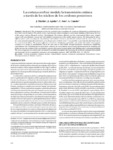La corteza cerebral modula la transmisión cutánea a través de los núcleos de los cordones posteriores

Ver/
Use este enlace para citar
http://hdl.handle.net/2183/236Coleccións
- GI-NEURO - Artigos [165]
Metadatos
Mostrar o rexistro completo do ítemTítulo
La corteza cerebral modula la transmisión cutánea a través de los núcleos de los cordones posterioresData
2001Cita bibliográfica
Revisiones en neurociencia, vol. 33, n. 5, p. 448-454
Resumo
The mechanisms used by the cerebral cortex to modulate the cutaneous information at prethalamic level
have been scarcely studied. This article reviews experimental evidence leading to a better understanding of this issue at the level
of the cuneate nucleus (Burdach nucleus). Development. The primary afferents and the corticocuneate fibers make synaptic
contact with cuneothalamic neurons and with inhibitory interneurons in the middle cuneate nucleus. By stimulating the skin at
different places while recording the cuneothalamic intracellular activity in anaesthetized animals with the cortex intact, with
the cortex pharmacologically inactivated, or in absence of a cerebral cortex it was possible to ascertain the functional role of
the corticocuneate fibers. The primary afferents activated by stimulating a particular zone of the skin induce monosynaptic
excitation on a group of cuneothalamic cells at the same time at which inhibit, through intranuclear interneurons, neighboring
cuneothalamic cells with unmatched receptive fields. Similarly, the corticocuneate cells receiving information from the stimulated skin
further increase the excitation of the cuneothalamic neurons with matched receptive fields while inhibiting others with unmatched fields.
The cortex exaggerates an excited center surrounded by an inhibited periphery thus increasing the tactile discrimination both spatially
and temporally which is essential for exploratory and manipulative purposes
Palabras chave
Cortical modulation
Cuneate nucleus
Cuneothalamic neurons
Cutaneous transmission
Sensorimotor cortex
Ventroposterolateral thalamic nucleus
Cuneate nucleus
Cuneothalamic neurons
Cutaneous transmission
Sensorimotor cortex
Ventroposterolateral thalamic nucleus





